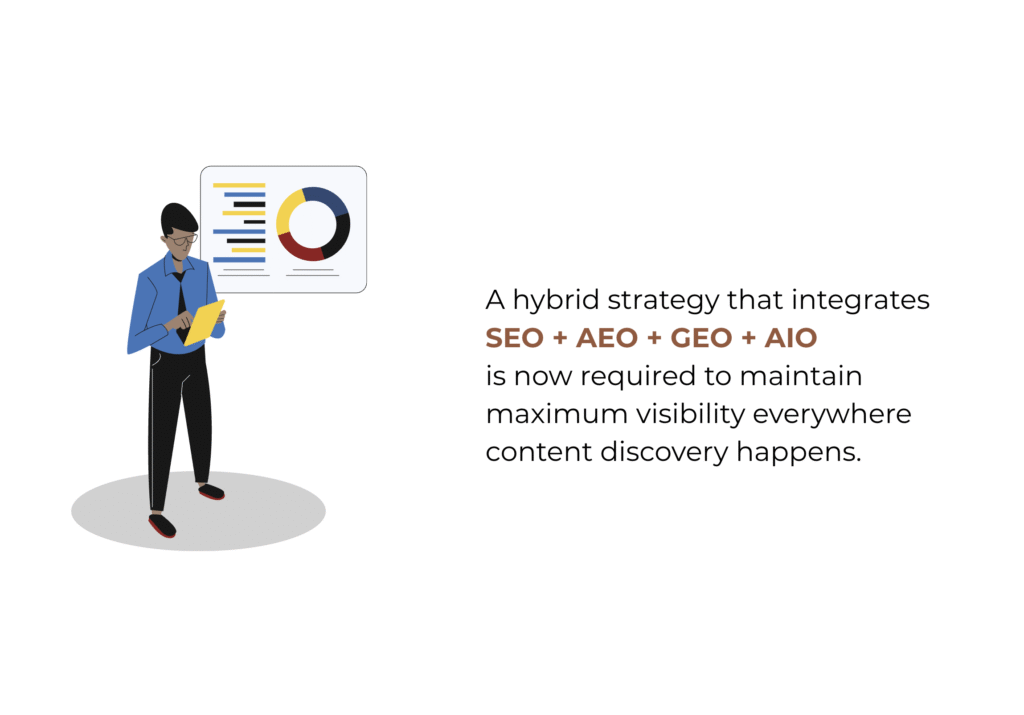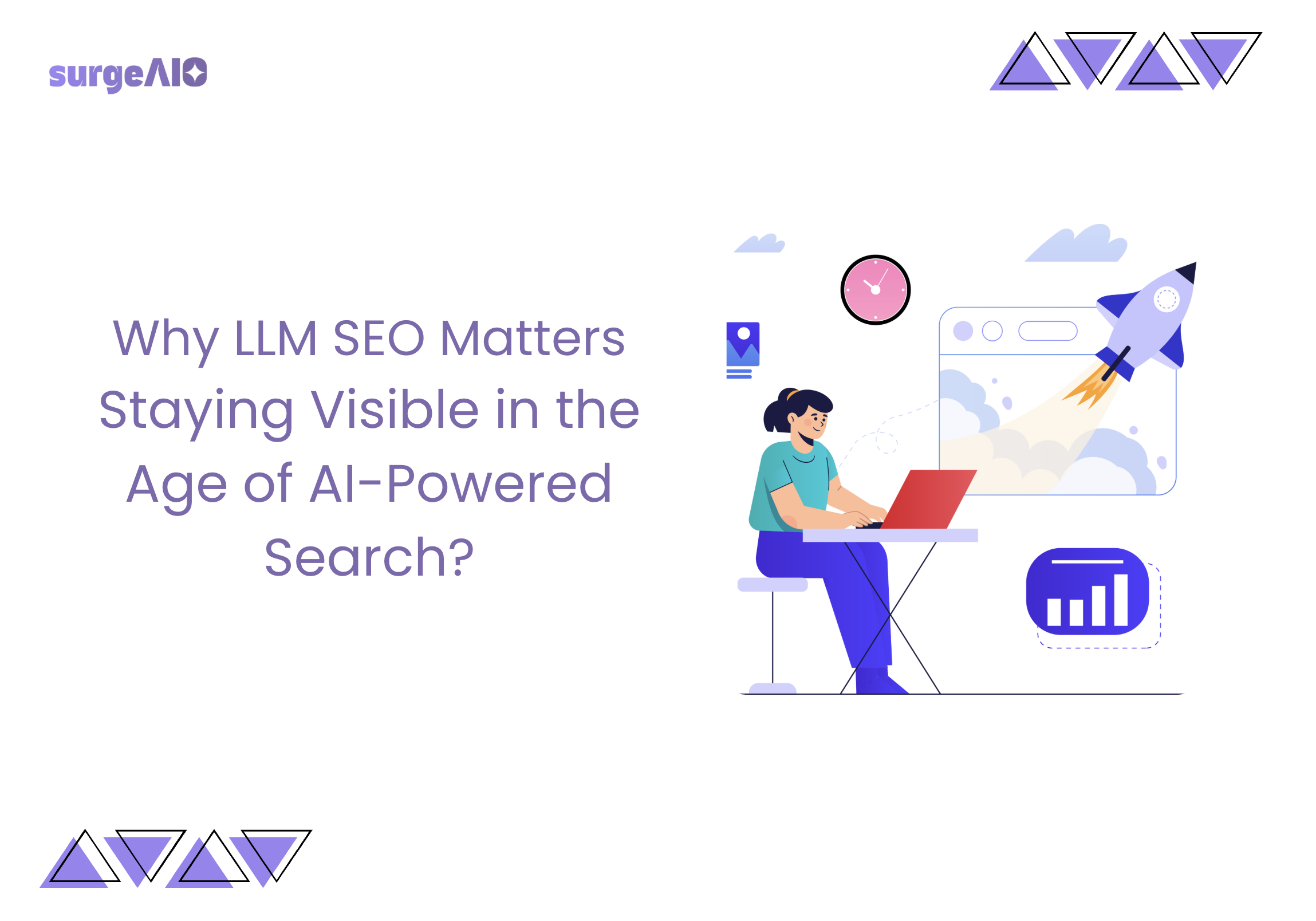Traditional SEO is no longer sufficient. As AI and large language models (LLMs) like ChatGPT, Google’s Gemini, and Perplexity become the dominant sources of information discovery, LLM SEO has rapidly emerged as a crucial strategy.
This new approach ensures brands are not only visible in search results, but actively cited in AI-generated answers.
In this article, you’ll discover:
- What LLM SEO is, and how it differs from traditional SEO
- Why it’s essential for modern brands
- Strategies to align your content with both traditional search and generative AI
- Steps to future-proof your content pipeline for AI‑driven visibility
What Is LLM SEO?
LLM SEO, also known as Large Language Model Optimization, Generative Engine Optimization (GEO), Answer Engine Optimization (AEO), or AI SEO, refers to optimizing web content so it can be understood, retrieved, and cited by generative AI models
Unlike traditional SEO that focuses on backlinks, keyword ranking, and link‑based discovery, LLM SEO centers on semantic relevance, topical authority, conversational clarity, and structured content that matches how AI systems interpret queries
The AI Search Revolution: Why It Matters Now
a) Shake‑Up of Traditional Search Traffic
Recent studies show that up to 80% of consumers resolve 40% of searches without clicking links, thanks to AI summaries on search engines and generative LLM tools. As a result, many brands are experiencing traffic declines even though their content remains relevant to users.
In response, companies like Mailchimp have adapted by optimizing their technical stack and page structure to serve AI crawlers better, emphasizing fast load speeds, accessible metadata, and “LLMs.txt” files to signal AI readiness.
b) AI Traffic Is Exploding
While still smaller than Google search volume, LLM‑driven traffic is growing fast. ChatGPT reportedly processes about 1 billion searches per week, up from nearly zero just a year ago, and usage increases by the month.
Projections suggest AI‑powered discovery may surpass traditional organic search traffic by as early as 2027–2028.
c) Zero‑Click, Citation‑Based Visibility
LLM SEO teaches that rank and click‑through aren’t the only metrics anymore. Becoming the answer, even without clicks, builds brand awareness, trust, and eventually branded searches.
Core Principles of Effective LLM SEO
a) Structure Content for Retrieval
AI models favor well-structured information, clear headings, Q&A formats, data tables, lists, and FAQ sections. These formats make content easy for models to parse, retrieve, and cite.
Creating comparison articles, “best of” lists, and transparent decision criteria increases the likelihood of being included in AI answers, even if you don’t rank on page one of Google
b) Write Conversationally and Contextually
LLMs process intent and semantics, not just keywords. A conversational tone that answers probable user questions naturally improves relevance in generative summaries.
Use plain language, answer real questions up front, and avoid keyword stuffing.
c) Build Topical Authority (Depth Over Brevity)
Deep, well-reasoned content that covers multiple angles of a topic is preferred by LLMs. Truly owning a concept, with context, definitions, case studies, and reasoning, enhances your chances of being pulled into generated responses.
Vercel’s engineering blog puts it well: “LLM SEO is the art of becoming the answer”
d) Maintain Technical Friendliness
Just like SEO, technical factors still matter. Ensure clean code, fast page load, structured data, crawlable content, and optionally an llms.txt file to guide AI indexing.
e) Seed Your Content Strategically (LLM Seeding)
Publish content that is likely to get scraped and cited, on your own site and external platforms (guest posts, industry sites, forums), with structured formats and authoritative tone. This method, called LLM seeding, builds AI citations organically
AEO, GEO, AIO, Understanding the Terminology
These terms overlap, but each has its nuance:
- AEO (Answer Engine Optimization): Focused on shaping how AI chatbots reply to user queries with concise, authoritative content
- GEO (Generative Engine Optimization): Aims to increase the likelihood that your content is cited in generative AI outputs by optimizing for AI-friendly formats and metadata.
- AIO (Artificial Intelligence Optimization): A broader category dealing with embedding, indexing, and prompt-compatibility to support AI retrieval mechanisms inside LLMs.

Why Brands That Ignore LLM SEO Risk Falling Behind?
a) Losing Visibility in AI‑Mediated Answers
If your content isn’t optimized for AI retrieval, you won’t appear in chatbot-driven summaries. That means losing authority, mindshare, and the chance to convert users who rely on AI answers directly
b) Declining Organic Traffic Without Compensation
Even with great traditional SEO, traffic may fall as users get answers via AI tools and never click through. Brands that don’t adapt will see declining web visits, yet gain no benefit from AI-generated brand exposure
c) Losing Competitive Edge
AI‑driven discovery favors brands that supply clear, structured, and context-rich content. From Semrush studies, lesser-known brands can get cited if they provide better AI‑ready content, often surfacing ahead of traditional ranking leaders
Ethan Smith and other experts note: traditional SEO veterans are often unprepared for this shift, and must rethink visibility metrics entirely
6. Practical Steps to Implement LLM SEO on SurgeAIO
Step 1: Identify Core Topics & User Questions
- Use chat logs, forum snippets, Reddit threads, and user support questions to derive real conversational queries users ask LLMs.
- Focus on emerging topics where you can establish thought leadership early.
Step 2: Craft Structured, Citation‑Friendly Content
- Use headings like “What is…?”, “How to…?”, “Why does it matter?”
- Include FAQ sections, bullet lists, comparison tables, and case studies.
- Explain data clearly and transparently, AI citation likelihood improves when reasoning steps and criteria are evident.
Step 3: Technical Optimization
- Ensure fast page load, clean HTML, structured data markup (JSON‑LD or Schema), and optionally llms.txt to control access by AI systems
- Use metadata, clear canonicalization, and internal linking to build contextual authority.
Step 4: Distribute & Seed Content in AI‑Friendly Contexts
- Publish on industry sites with structured formats, allow LLMs to crawl and cite.
- Use guest posts, knowledge bases, blog platforms, or forums with high AI crawlability.
- Ensure content is formatted in an LLM‑digestible way (headings, short paragraphs, clear reasoning)
Step 5: Monitor AI Mentions & Brand Citations
- Use tools now tracking mentions in ChatGPT, Gemini, and Perplexity.
- Track trending prompts and queries where your brand appears, that visibility can lead to branded search and direct traffic even without link clicks
Best Practices & Tips for Ongoing Success
- Update regularly. AI models value freshness, periodic content refresh signals that your information remains current and authoritative.
- Be semantically rich. Use synonyms, context clues, examples, and related topics to reinforce embeddings that match AI retrieval.
- Write with natural conversations in mind. Imagine real prompts users might type. Frame your content to directly answer those queries.
- Track performance beyond links. Monitor changes in branded search volume, AI mentions, and referral traffic rather than relying solely on click-through metrics.
- Balance SEO and LLM readiness. Implement a coordinated strategy combining keyword targeting with conversational and structured AI‑friendly formats
What Early Adopters Are Doing?
Back Market, an e‑commerce brand, adopted more conversational product copy and optimized product pages to align with LLM preferences. It began capturing AI citations even before achieving top page‑one rankings on Google.
Mailchimp enhanced its site structure and metadata to better serve the AI systems that crawl content for generative summaries.
A wave of startups offering AEO/GEO/AIO platforms have emerged in 2025, supporting analytics, prompt‑tracking, and LLM visibility for brands adapting to the shift.
The Future Outlook: How LLM SEO Will Evolve
- Greater AI model integration: LLMs with live web access, real‑time retrieval, and multimodal capabilities (text + visuals) will dominate discovery channels.
- AI commerce and shopping: As tools like ChatGPT roll out integrated shopping buttons, being cited in AI responses can directly drive conversions without traditional search click paths.
- Dominance of answer‑first interfaces: If AI platforms become primary entry points to content, brands that invest in LLM SEO will win visibility even if they don’t rank highly on traditional SERPs.
Conclusion
LLM SEO isn’t just the next iteration of SEO, it’s a fundamental shift. The goal is no longer to climb to the top of rankings or drive clicks, but to own the answer. By optimizing content around semantic clarity, structured formats, topical depth, and AI‑seeding strategies, brands like yours can remain discoverable and authoritative in both conventional search and AI‑mediated discovery channels.
If you want help mapping LLM‑ready content, refining your structure, or tracking AI mentions for SurgeAIO, I’d be glad to assist. Let’s make sure your brand stays the answer in the era of AI search.


